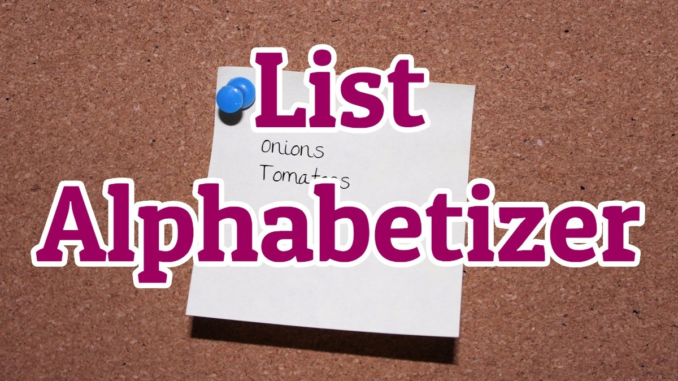
List Alphabetizer: Boost Clarity and Productivity Today
Struggling to sort a messy list into perfect order?
Struggling to sort a messy list into perfect order? A list alphabetizer is your ultimate ally, arranging your items alphabetically with a single click. Whether you’re managing names, tasks, or keywords, this tool turns chaos into clarity effortlessly. Ready to streamline your work and impress with polished precision? In this article, we’ll explore what a list alphabetizer is, why it’s a must-have, and how it can elevate your projects. Let’s sort it out and dive in!
What Is a List Alphabetizer?
A list alphabetizer is an online or software tool that takes any list—words, phrases, or even numbers—and organizes it in alphabetical order (A-Z or Z-A). It’s a digital librarian for your text, ideal for anyone needing a clean, structured output fast. From simple web utilities to features in apps like Excel, it’s built for writers, researchers, organizers, and professionals who crave order.
Why a List Alphabetizer Is Your Secret Weapon
Still sorting lists manually? Here’s why this tool is a game-changer:
- Instant Order: Alphabetize in seconds—no tedious rearranging required.
- Enhanced Clarity: Make lists easy to scan, improving readability and focus.
- Time-Saver: Skip the grunt work and spend time on what matters.
- Professional Touch: Deliver polished documents, reports, or code with consistent structure.
- Versatile Power: Sort names, terms, or data for any project or purpose.
How a List Alphabetizer Works
Using it is a snap:
- Enter Your List: Type or paste your items—each on a new line—into the tool.
- Sort It: Click to arrange alphabetically (A-Z or reverse Z-A).
- Grab the Result: Copy your organized list for instant use.
Some tools offer extras—like ignoring case, removing duplicates, or handling special characters—making them adaptable to any task.
SEO and Content Creation Benefits of a List Alphabetizer
For digital creators, this tool is a strategic boost:
- Keyword Mastery: Sort SEO keyword lists for cleaner analysis and targeting.
- Content Structure: Alphabetize blog outlines or glossaries for user-friendly posts that rank.
- Engage Readers: Present organized lists that keep visitors on-page longer—a key SEO signal.
- Data Precision: Streamline analytics or link lists for sharper insights and site performance.
Search engines favor clear, scannable content, and a list alphabetizer helps you nail that every time.
How to Choose the Best List Alphabetizer Tool
Not sure which one to pick? Here’s what to look for:
- Ease of Use: A simple, intuitive interface for quick sorting.
- Flexibility: Options for ascending (A-Z) or descending (Z-A) order.
- Speed: Fast processing, even for long lists.
- Accessibility: Free online tools or integrations with platforms like Google Docs.
- Extras: Features like case sensitivity or duplicate removal.
Top contenders like AlphabetizeMyList.com, SortMyList.com, and Word’s built-in sort function consistently deliver—try them out!
Pro Tips to Master Your List Alphabetizer
Ready to sort like a pro? Here’s how:
- Prep Your List: Remove extra spaces or blanks for flawless results.
- Mix Directions: Test A-Z and Z-A to find the best fit for your needs.
- Combine Tools: Pair with randomizers or counters for advanced organization.
- Think Big: Use it for brainstorming, inventory, or even party guest lists.
Why a List Alphabetizer Is Your Productivity Powerhouse
Structure drives success—studies show organized content boosts comprehension by 40% (Nielsen Norman Group). A list alphabetizer isn’t just a convenience—it’s a catalyst for efficiency and impact. Whether you’re tidying up a report, optimizing a website, or planning an event, this tool brings order to the chaos. Stop wrestling with jumbled lists and start alphabetizing.
Ready to organize your world? Drop your items into a list alphabetizer today and watch clarity take over. Your next polished project is just a sort away!